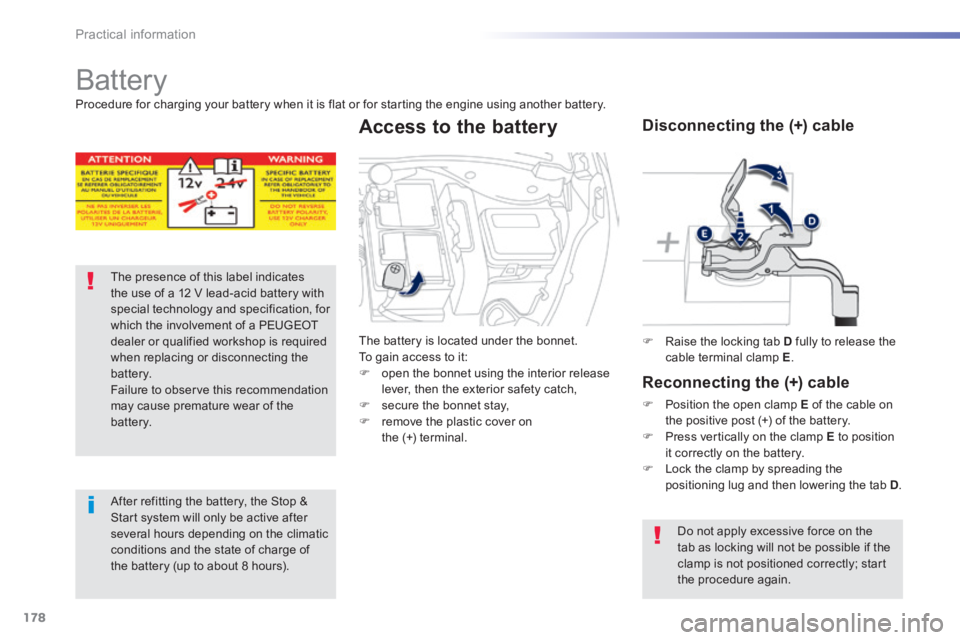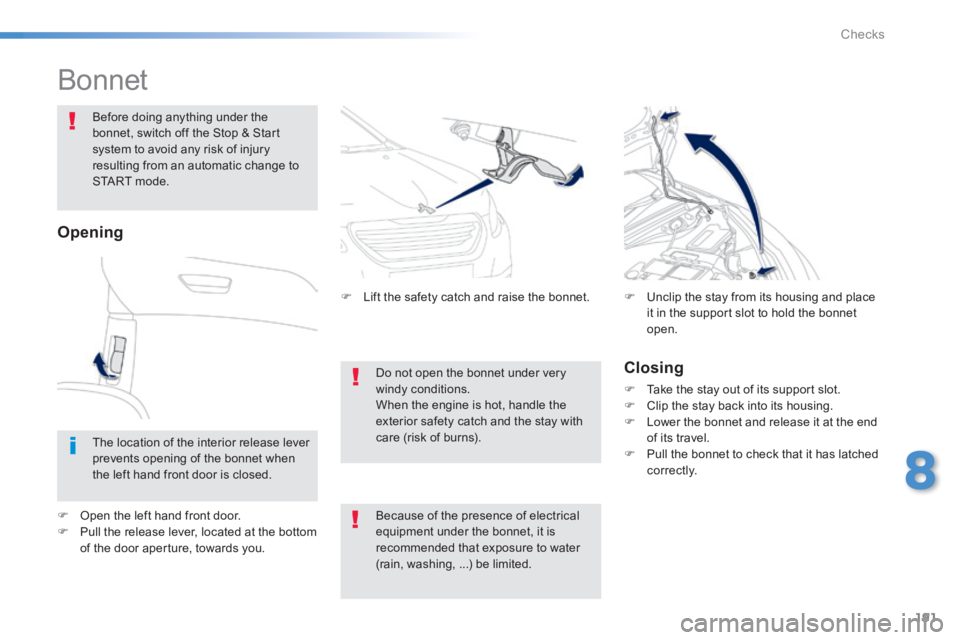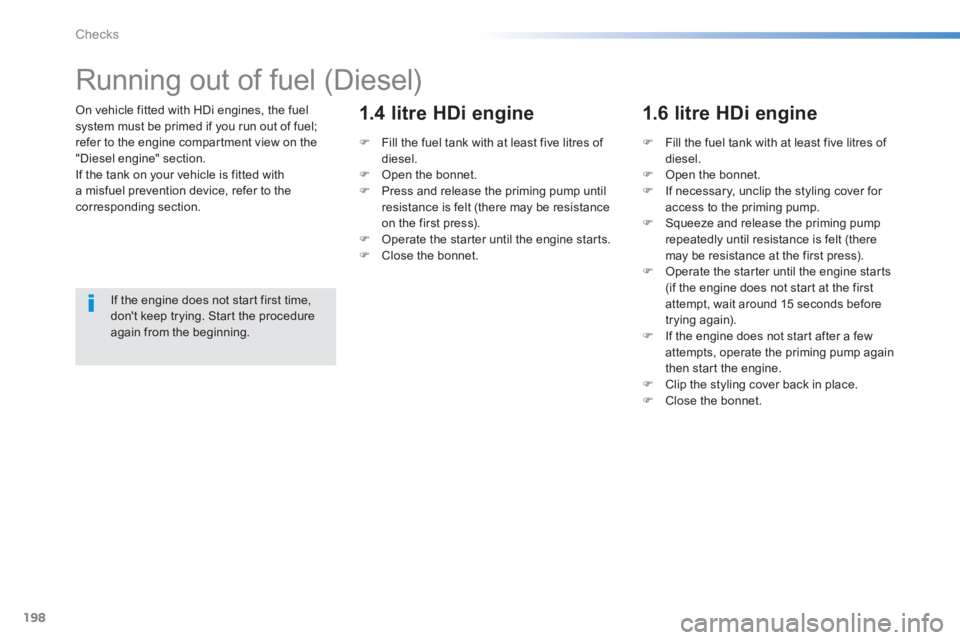Page 8 of 336
6
194
44
191
Familiarisation
Open
A. Unfolding / Folding the key. B . Unlocking the vehicle . Deactivation of the alarm.
Remote control key Bonnet
1. Opening the fuel filler flap by pressing at its r e a r. 2. Opening the fuel filler cap.
3. Hooking the fuel filler cap. Tank capacity: approximately 50 litres.
A. Interior release lever. B. Exterior safety catch C. Bonnet stay.
Other functions...C. Locking the vehicle.
Location of the vehicle. Activation of the alarm.
Fuel tank
Page 10 of 336

8Familiarisation
11. Front side window demisting/defrosting vent. 12 . Instrument panel. 13. Windscreen demisting/defrosting vent. 14 . Sunshine sensor. 15. Glove box / Passenger's airbag deactivation. 16. Passenger's airbag. 17. Multifunction screen / Audio system. 18. Central adjustable air vents. 19. Central locking and hazard warning buttons.
Instruments and controls
1. Cruise control / speed limiter controls. 2. Steering mounted controls for the touch screen. 3. Wiper / screenwash / trip computer stalk. 4. Lighting and direction indicator stalk 5. Bonnet release lever. 6. Steering wheel adjustment control. 7. Driver's airbag. Horn. 8. Headlamp height adjustment. 9. Switch panel. 10. Side adjustable air vents.
20. Heating / air conditioning controls. 21. 12 V accessory socket. USB port / auxiliary socket. Additional USB port. 22. Open storage. Cup holder. 23. Gear lever. 24. Grip control switch. 25. Parking brake. 26. Panoramic sunroof blind opening and closing control. 2 7. Closed storage compartment. 28. Rear 12 V socket.
Page 53 of 336

51
2
Access
System which protects and provides a deterrent against theft and break-ins. It provides the following types of monitoring:
Alarm
- Exterior perimeter
The system checks for opening of the vehicle. The alarm is triggered if anyone tries to open a door, the boot, the bonnet...
- Interior volumetric
The system checks for any variation in the volume in the passenger compartment. The alarm is triggered if anyone breaks a window, enters the passenger compartment or
moves inside the vehicle.
Self-protection function
The system checks for the putting out of service of its components. The alarm is triggered if the battery, the central control or the wires of the siren are put out of service or damaged.
For all work on the alarm system, contact a PEUGEOT dealer or a qualified workshop.
Locking the vehicle with full
alarm system
Activation
Switch off the ignition and get out of the vehicle.
Press the locking button on the remote control.
After the locking button on the remote control is pressed, the exterior perimeter monitoring is activated after a delay of 5 seconds and the interior volumetric monitoring after a delay of 45 seconds. If an opening (door, boot...) is not closed fully, the vehicle is not locked but the exterior perimeter monitoring will be activated after a
delay of 45 seconds at the same time as the interior volumetric monitoring.
Press the unlocking button on the remote control.
Deactivation
The alarm system is deactivated: the indicator lamp in the button goes off. The monitoring system is active: the indicator lamp in the button flashes once per second.
Page 180 of 336

178
Practical information
Battery
The presence of this label indicates the use of a 12 V lead-acid battery with special technology and specification, for which the involvement of a PEUGEOT dealer or qualified workshop is required when replacing or disconnecting the battery. Failure to observe this recommendation may cause premature wear of the battery.
After refitting the battery, the Stop & Start system will only be active after several hours depending on the climatic conditions and the state of charge of the battery (up to about 8 hours).
Raise the locking tab D fully to release the cable terminal clamp E .
Disconnecting the (+) cable
Reconnecting the (+) cable
Position the open clamp E of the cable on the positive post (+) of the battery.
Press vertically on the clamp E to position it correctly on the battery. Lock the clamp by spreading the positioning lug and then lowering the tab D .
Do not apply excessive force on the tab as locking will not be possible if the clamp is not positioned correctly; start the procedure again.
Procedure for charging your battery when it is flat or for starting the engine using another battery.
The battery is located under the bonnet. To gain access to it: open the bonnet using the interior release lever, then the exterior safety catch, secure the bonnet stay, remove the plastic cover on
the (+) terminal.
Access to the battery
Page 193 of 336

191
8
Checks
Bonnet
Before doing anything under the bonnet, switch off the Stop & Start system to avoid any risk of injury resulting from an automatic change to START mode.
Closing
Take the stay out of its support slot. Clip the stay back into its housing. Lower the bonnet and release it at the end of its travel. Pull the bonnet to check that it has latched c o r r e c t l y.
Unclip the stay from its housing and place it in the support slot to hold the bonnet open.
Do not open the bonnet under very windy conditions. When the engine is hot, handle the exterior safety catch and the stay with care (risk of burns).
Opening
Lift the safety catch and raise the bonnet.
Open the left hand front door. Pull the release lever, located at the bottom of the door aperture, towards you.
Because of the presence of electrical equipment under the bonnet, it is recommended that exposure to water (rain, washing, ...) be limited.
The location of the interior release lever prevents opening of the bonnet when the left hand front door is closed.
Page 200 of 336

198
Checks
On vehicle fitted with HDi engines, the fuel system must be primed if you run out of fuel; refer to the engine compartment view on the "Diesel engine" section. If the tank on your vehicle is fitted with a misfuel prevention device, refer to the corresponding section.
Running out of fuel (Diesel)
If the engine does not start first time, don't keep trying. Start the procedure again from the beginning.
Fill the fuel tank with at least five litres of diesel. Open the bonnet. Press and release the priming pump until resistance is felt (there may be resistance on the first press). Operate the starter until the engine starts. Close the bonnet.
1.4 litre HDi engine
Fill the fuel tank with at least five litres of diesel. Open the bonnet. If necessary, unclip the styling cover for access to the priming pump. Squeeze and release the priming pump repeatedly until resistance is felt (there may be resistance at the first press). Operate the starter until the engine starts (if the engine does not start at the first attempt, wait around 15 seconds before trying again). If the engine does not start after a few attempts, operate the priming pump again then start the engine. Clip the styling cover back in place. Close the bonnet.
1.6 litre HDi engine
Page 323 of 336
.
321
Visual search
Instruments and controls
Courtesy lamps 121 Interior mood lighting 122 Rear view mirror 62 Emergency or assistance call 124, 213
Manual parking brake 80
Manual gearbox 81 5-speed electronic gearbox 82- 84 6-speed electronic gearbox 85-88 Automatic gearbox 89 -91 Gear shift indicator 92 Stop & Start 93 -95 Hill start assist 96
Heating, ventilation 63-66 Manual air conditioning 65-66 Dual-zone air conditioning 67-69 Front demisting / defrosting 70 Rear screen emist/defrost 70
Bluetooth audio system 277-302
Audio system 303 -318
Setting the date/time 43
Dashboard fuses 172-174
Touch screen 215 -276
Opening the bonnet 191
USB port / Auxiliary socket 73 Additional USB port 73
Door mirrors 61- 62 Electric windows, deactivating 53-54
Glove box fuses 175 -176
Page 325 of 336
.
323
Visual search
Maintenance - Technical data
Identification markings 212 Dimensions 211
Changing bulbs 165-171 - front - rear
Running out of fuel, Diesel 198
Opening the bonnet 191 Under the bonnet, petrol 192 Under the bonnet, Diesel 193 Petrol engines 204 Diesel engines 206-207
12V battery 178 -180 Load reduction, energy economy mode 181 Engine compartment f u s e s 172-173 , 17 7
Petrol weights 205 Diesel weights 208 -210
Checking levels 199 -201 - oil - brake fluid - coolant - screenwash fluid - additive (Diesel with particle emissions filter) Checking components 202-203 - battery - air / passenger compartment filter - oil filter - particle emissions filter (Diesel) - brake pads / discs